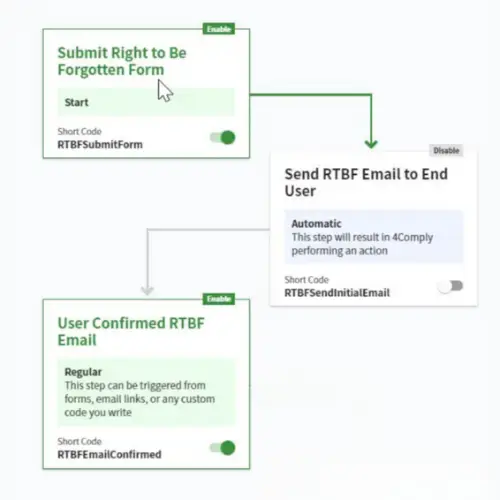
Key Takeaways
- Automate DSARs → ensure timely and accurate compliance.
- Centralize requests → create a single source of truth.
- Customize workflows → fit your unique business processes.
- Verify identities → prevent unauthorized data access securely.
- Build customer trust → handle data requests transparently.
Mastering rights fulfillment workflows through DSAR automation
Every business strives to build lasting customer trust, and handling personal data with care is a critical part of that promise. When you respect data subject rights, you show customers you value them, strengthening loyalty and brand reputation. Yet, the reality of managing each data request manually is complex and risky. Juggling spreadsheets and emails often leads to missed deadlines and human error, putting both your compliance status and customer relationships on the line. This is why a streamlined approach is essential. Mastering rights fulfillment workflows through DSAR automation transforms this challenge from a resource drain into a powerful tool for building brand integrity.
What Are Rights Fulfillment Workflows?
At its core, a rights fulfillment workflow is the end-to-end process a company uses to respond to a Data Subject Access Request (DSAR). When a customer asks to see, correct, or delete their personal data, it triggers a legal obligation for you to act. An effective workflow ensures these requests are received, verified, tracked, and fulfilled accurately and on time. While this can be done manually, modern privacy compliance demands a more robust solution. DSAR automation systematizes these steps, creating a seamless, auditable, and efficient process that minimizes risk and ensures nothing falls through the cracks.
Why Are They Critical for Your Business?
Beyond simple compliance, a well-managed rights fulfillment workflow is a cornerstone of customer trust. In an era where data privacy is a primary concern for consumers, demonstrating a commitment to protecting their rights is a powerful differentiator. Efficiently handling customer data requests shows that you are a responsible steward of their information, which builds brand loyalty. Conversely, a clunky or slow process can lead to customer frustration, brand damage, and severe penalties under regulations like GDPR and CCPA. A streamlined workflow isn’t just a legal shield; it’s a business asset that reinforces your reputation for integrity.
How to Implement an Effective DSAR Workflow
Implementing a structured workflow transforms how you manage DSARs, turning a potential compliance headache into a streamlined operation. The process generally involves four key stages:

- Intake: It starts with a centralized and easily accessible portal or form where users can submit their requests. This avoids the chaos of requests coming through various channels like emails or support tickets.
- Verification: Before providing any data, you must securely verify the identity of the person making the request. This crucial step prevents unauthorized access and potential data breaches.
- Data Discovery: Once verified, the next step is to locate and gather all the relevant personal information from your various systems. This is often the most time-consuming part of the manual process.
- Fulfillment: Finally, the collected information is delivered securely to the user in a clear and understandable format. For deletion requests, this stage involves ensuring the data is permanently removed from your systems.
Best Practices for Managing Data Subject Rights
To truly excel at privacy compliance, consider these best practices:
- Automate Where Possible: Leverage DSAR automation tools like 4Comply to handle the repetitive, time-consuming tasks of verification, data discovery, and tracking.
- Maintain a Clear Audit Trail: Keep detailed records of every request, action taken, and communication. This is essential for demonstrating compliance if an audit occurs.
- Train Your Team: Ensure everyone who handles personal data understands the importance of data subject rights and knows the correct procedures to follow.
- Be Transparent: Clearly communicate your data privacy policies to users and keep them informed about the status of their requests throughout the fulfillment process.
Build Customer Trust with 4Comply
Navigating the complexities of privacy compliance and rights fulfillment can be daunting, but you don’t have to do it alone. The right tools can transform your workflow from a manual burden into a seamless, automated process that builds customer trust and ensures you meet your legal obligations.
If you’re ready to take control of your DSAR automation, 4Comply offers a robust solution designed to manage the entire lifecycle of data subject requests.
Ready to see how it works? Request a personalized demo of 4Comply today!
Frequently Asked Questions (FAQs)
A user emailed asking for their data. What’s the absolute first step?
Verify the user’s identity. Before you access, send, or delete any information, you must have a secure process to confirm the person is who they say they are. This prevents a potential data breach.
How long do you have to respond to a data request under GDPR?
A month. Under GDPR, you have one calendar month from the date you receive the request to provide a response. This timeframe can be extended by up to two additional months for complex requests, but you must inform the user of the extension within the first month.
Why is just emailing data back to a user a security risk?
Email is not an inherently secure channel for transferring sensitive personal data. It can be intercepted, sent to the wrong address, or accessed on an insecure device. Fulfilling a data request requires a secure delivery method to protect the user’s privacy and your business from liability.
How do data rights differ between major privacy laws like GDPR and CCPA?
While core principles like the right to access and delete data are similar, the specifics vary greatly. Major laws like Europe’s GDPR and California’s CCPA have different response timelines, user verification standards, and penalties. This makes a flexible, region-aware compliance strategy essential for global businesses.
Does the ‘right to be forgotten’ apply to data in backups?
This is a complex area, but generally, yes. While you may not need to immediately erase data from disaster recovery backups, you must ensure the data is quarantined and not restored into your live systems. Eventually, it must be permanently deleted as the backup lifecycle expires.
How can you prove you have complied with a deletion request?
The only way to prove compliance is by maintaining a secure, unalterable audit trail. This log should record the initial request, the identity verification steps, the actions taken to delete the data, and the final confirmation sent to the user. This trail is your essential legal record.





